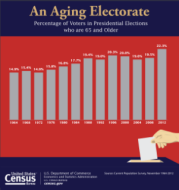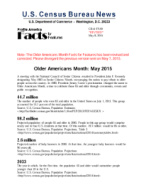For Immediate Release: Friday, May 08, 2015
Facts for Features: Older Americans Month: May 2015
Note: The Older Americans Month Facts for Features has been revised and corrected. Please disregard the previous version sent on May 7, 2015.
A meeting with the National Council of Senior Citizens resulted in President John F. Kennedy designating May 1963 as Senior Citizens Month, encouraging the nation to pay tribute to older people across the country. In 1980, President Jimmy Carter’s proclamation changed the name to Older Americans Month, a time to celebrate those 65 and older through ceremonies, events and public recognition.
Graphic [JPG]
44.7 million
The number of people who were 65 and older in the United States on July 1, 2013. This group accounted for 14.1 percent of the total population.
Source: U.S. Census Bureau, Population Estimates
<//factfinder.census.gov/bkmk/table/1.0/en/PEP/2013/PEPAGESEX>
98.2 million
Projected population of people 65 and older in 2060. People in this age group would comprise nearly one in four U.S. residents at that time. Of this number, 19.7 million would be 85 or older.
Source: U.S. Census Bureau, Population Projections, Table 3
<//www.census.gov/population/projections/data/national/2014/summarytables.html>
2.6 million
Projected number of baby boomers in 2060. At that time, the youngest baby boomers would be 96 years old.
Source: U.S. Census Bureau, Population Projections
<//www.census.gov/population/projections/data/national/2014.html>
2033
The year in which, for the first time, the population 65 and older would outnumber people younger than 18 in the U.S.
Source: U.S. Census Bureau, Population Projections
<//www.census.gov/population/projections/data/national/2014.html>
Income and Poverty
$35,611
The 2013 median income of households with householders 65 and older, up 3.7 percent from the previous year.
Source: U.S. Census Bureau, Income, Poverty, and Health Insurance Coverage in the United States: 2013, Table 1
<//www.census.gov/content/dam/Census/library/publications/2014/demo/p60-249.pdf>
9.5%
The percent of people 65 and older (4.2 million) who were in poverty in 2013.
Source: U.S. Census Bureau, Income, Poverty, and Health Insurance Coverage in the United States: 2013, Table 3
<//www.census.gov/content/dam/Census/library/publications/2014/demo/p60-249.pdf>
$170,516
Median net worth for householders 65 and older in 2011.
Source: U.S. Census Bureau, Net Worth and Asset Ownership of Households: 2011
<//www.census.gov/people/wealth>
14.6%
Percent supplemental poverty rate for those 65 and older, equating to 6.5 million people. Excluding Social Security would leave the majority of this population in poverty.
Source: U.S. Census Bureau, Current Population Reports, Supplemental Poverty Measure: 2013
<//census.gov/content/dam/Census/library/publications/2014/demo/p60-251.pdf>
Serving Our Nation
9.3 million
Estimated number of people 65 and older who were veterans of the U.S. Armed Forces in 2013.
Source: U.S. Census Bureau, 2013 American Community Survey
<//factfinder.census.gov/bkmk/table/1.0/en/ACS/13_1YR/B21001>
Jobs
21.5%
Labor force participation rate for men 65 and older in 2013, significantly higher than the rate for women 65 and older at 13.8 percent.
Source: U.S. Census Bureau, 2013 American Community Survey Table B23001
<//factfinder.census.gov/bkmk/table/1.0/en/ACS/13_5YR/B23001>
4.9 million
Number of full-time, year-round workers 65 and older with earnings in 2013, up from 1.5 million in 1993.
Source: U.S. Census Bureau, Current Population Survey, Historical Income Tables: People, Table P-32
<//www.census.gov/hhes/www/income/data/historical/people/>
Education
83.6%
Proportion of people 65 and older in 2014 who had completed high school or higher education.
Source: U.S. Census Bureau, Educational Attainment in the United States: 2014, Table 1 All Races
<//www.census.gov/hhes/socdemo/education/data/cps/2014/tables.html>
26.3%
Percentage of the population 65 and older in 2014 who had earned a bachelor’s degree or higher.
Source: U.S. Census Bureau, Educational Attainment in the United States: 2014, Table 1 All Races
<//www.census.gov/hhes/socdemo/education/data/cps/2014/tables.html>
Marital Status and Living Arrangements
58.6%
Percentage of people 65 and older who were married in 2014.
Source: U.S. Census Bureau, Families and Living Arrangements, Table A1
<//www.census.gov/hhes/families/files/cps2014/tabA1-all.xls>
24.7%
Percentage of people 65 and older in 2014 who were widowed.
Source: U.S. Census Bureau, Families and Living Arrangements, Table A1
<//www.census.gov/hhes/families/files/cps2014/tabA1-all.xls>
Computer and Internet Use
71%
The percentage of those 65 and older who reported living in homes with computers in 2013. Additionally, 62.4 percent accessed the Internet through a high-speed Internet connection.
Source: U.S. Census Bureau, Computer and Internet Use, Table 2
<//census.gov/content/dam/Census/library/publications/2014/acs/acs-28.pdf>
Voting
72.0%
Percentage of citizens 65 and older who reported casting a ballot in the 2012 presidential election.
Source: U.S. Census Bureau, Voting and Registration in the Election of November 2012, Table 2
<//www.census.gov/hhes/www/socdemo/voting/publications/p20/2012/tables.html>
Homeownership
79.5%
Percentage of householders 65 and older who owned their homes as of fourth quarter 2014.
Source: U.S. Census Bureau, Current Population Survey/Housing Vacancy Survey, Table <//www.census.gov/housing/hvs/data/q414ind.html>
Services for the Older Population
4,792
Number of continuing care retirement communities in 2012. These businesses employed 426,109 workers and generated $27.7 billion in revenues. In 2007, there were 5,939 such establishments, employing 442,219 people and producing $26.0 billion in revenues. These establishments provide a range of residential and personal care services with on-site nursing care facilities for the elderly and other persons who are unable to fully care for themselves and the elderly and other persons who do not desire to live independently. Individuals live in a variety of residential settings with meals, housekeeping, social, leisure, and other services available to assist residents in daily living.
Source: 2012 and 2007 Economic Census Industry Series (NAICS 623311)
25,899
Number of business establishments providing services for the elderly and people with disabilities in 2012. These businesses employed 911,331 workers and generated $34.4 billion in revenues. In 2007, there were 20,433 such establishments, employing 621,545 people and producing $25.3 billion in revenues. Senior citizens centers are among the establishments in this industry.
Source: 2012 and 2007 Economic Census Industry Series (NAICS 624120)
On the Map
18.7%
Percentage of Florida’s population that was 65 and older in 2013, followed by Maine (17.7 percent) and West Virginia (17.3 percent). Alaska had the lowest percentage (9 percent), followed by Utah (9.8 percent) and Texas (11.2 percent).
Source: U.S. Census Bureau, Population Estimates
<//factfinder.census.gov/bkmk/table/1.0/en/PEP/2013/PEPAGESEX/0400000US02|0400000US12|0400000US23|0400000US48|0400000US49|0400000US54?slice=GEO~0400000US02>
51.6%
Percentage of the population in Sumter, Fla., that was 65 and older in 2013 – which led all of the nation’s counties and Chattahoochee, Ga. (3.8 percent) had the lowest percentage.
Source: U.S. Census Bureau, Population Estimates
<//www.census.gov/newsroom/archives/2014-pr/cb14-118.html>
114,350
The estimated July 1, 2014 population of The Villages, Fla., metro area. The Villages, located to the west of the Orlando metro area, was the nation’s fastest-growing metro area between July 1, 2013, and July 1, 2014, with its population increasing by 5.4 percent. The metro area is home to one of the largest age-restricted retirement communities in the world.
Source: 2014 metro area population estimates
<//www.census.gov/newsroom/press-kits/2015/20150326_popestimates.html>
Centenarians
53,364
The number of people age 100 and older counted by the 2010 Census.
Source: U.S. Census Bureau, Centenarians: 2010
<//www.census.gov/prod/cen2010/reports/c2010sr-03.pdf>
20.7
For every 100 centenarian women, the number of centenarian men in 2010.
Source: U.S. Census Bureau, Centenarians: 2010
<//www.census.gov/prod/cen2010/reports/c2010sr-03.pdf>
43.5%
In 2010, percentage of centenarian men who lived with others in a household, the most common living arrangement for this group. For their female counterparts, the most common living arrangement was residing in a nursing home (35.2 percent).
Source: U.S. Census Bureau, Centenarians: 2010
<//www.census.gov/prod/cen2010/reports/c2010sr-03.pdf>
3.29
Number of centenarians per 10,000 people in North Dakota in 2010. North Dakota was the only state with more than three centenarians per 10,000 people.
Source: U.S. Census Bureau, Centenarians: 2010
<//www.census.gov/prod/cen2010/reports/c2010sr-03.pdf>
The following is a list of observances typically covered by the Census Bureau’s Facts for Features series:
| Black (African American) History Month (February) Super Bowl Valentine's Day (Feb. 14) Women's History Month (March) Irish-American Heritage Month (March)/ St. Patrick's Day (March 17) Earth Day (April 22) Asian/Pacific American Heritage Month (May) Older Americans Month (May) Mother's Day Hurricane Season Begins (June 1) Father's Day |
The Fourth of July (July 4) Anniversary of Americans With Disabilities Act (July 26) Back to School (August) Labor Day Grandparents Day Hispanic Heritage Month (Sept. 15-Oct. 15) Unmarried and Single Americans Week Halloween (Oct. 31) American Indian/Alaska Native Heritage Month (November) Veterans Day (Nov. 11) Thanksgiving Day The Holiday Season (December) |
Editor’s note: The preceding data were collected from a variety of sources and may be subject to sampling variability and other sources of error. Facts for Features are customarily released about two months before an observance in order to accommodate magazine production timelines. Questions or comments should be directed to the Census Bureau’s Public Information Office: telephone: 301-763-3030; or e-mail: [email protected].





